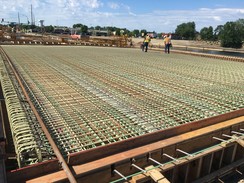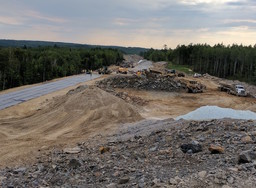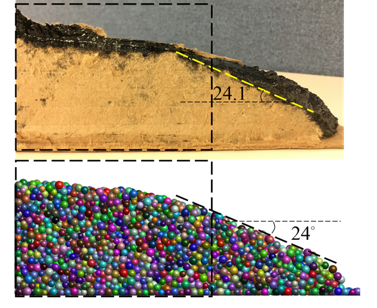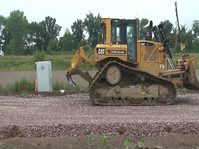|
Idea solicitation for the 2020 academic transportation research program is open. Submit your ideas on Ideascale by Monday, March 16 for consideration in the 2020 research RFP. Ideas submitted after March 16 will be included in the 2021 cycle. MnDOT research implementation projects can be proposed at any time.

Because building a bridge is enormously complicated, engineers begin planning bridge construction projects years in advance. Staging, materials, traffic control and budgets must all be considered. Accurately estimating how long construction will take can reduce cost overruns and is essential for managing traffic control needs. Because estimations are incorporated into construction contracts, they must be as accurate as possible.
A new spreadsheet-based tool allows engineers to project time frames based on bridge design elements, work scheduling and other inputs. The tool draws on bridge construction data stored in a database of comparable projects completed in the past 10 years. The database will continue to expand with details from more bridge projects, making future project estimates even more accurate.
For more information, check out Technical Summary 2020-01 (PDF).
|

Across Minnesota and especially in northern regions of the state, the bedrock and surface rocks left over from glaciers contain minerals that are potentially acid-generating (PAG). When exposed to air and water, this sulfur-rich rock and soil can produce acidic drainage that can contaminate surface and groundwater, and harm vegetation and aquatic life.
PAG becomes particularly problematic for highway construction projects that expose and use local bedrock and soil. Acid generated from these materials can degrade pavements, corrode metal and make slopes unstable.
A new, comprehensive manual helps MnDOT decision-makers identify and mitigate the effects of PAG materials at future highway construction sites. This resource incorporates insights from past Minnesota highway projects, the Minnesota Department of Natural Resources and other state transportation agencies.
For more information, check out Technical Summary 19-40 (PDF).
|

Snowplow operators need to clear all sorts of interchanges and intersection configurations, including roundabouts and highway on-ramps. Through a project funded by the MnDOT-led Clear Roads multi-state pooled fund, researchers documented best practices in snow removal for various intersection geometries.
They created a practice manual, reference cards and a 66-minute video showcasing the most efficient pass sequences. These tools will not only help better train operators—resulting in more effective plowing—but will help Minnesota’s transportation agencies manage resources and justify the purchase of specialized equipment such as wing plows.
For more information, check out Clear Roads Project 14-03.
|

Summer heat at a paving site can push temperatures to 125 degrees Fahrenheit (°F). The safety and comfort of road crews are some of the challenges of summer projects; another is the asphalt itself. In high heat, the aged binder in recycled material can affect the workability of the mix. Under these conditions, crews often reduce the amount of added binder to maintain a workable product. But is that a good solution?
To evaluate this practice, investigators gathered mixes used in the field, prepared blends with standard and lowered amounts of binder, and tested performance at various temperatures. The results generally confirm that less binder can be used at work sites during hot weather. At room temperature, the standard 2.5% to 3% new binder level remains best. But at 110°F, 1.75% mixes met performance tests, and at 125°F, 1.5% mixtures showed good performance. As working temperatures rise, compaction and density improve. While some other qualities deteriorate, the asphalt still meets performance standards.
The best news is that reducing binder levels to 1.5% can trim $200,000 from expenses for 5 miles of a two-lane rural highway. A more workable asphalt, shorter labor windows and reduced material costs produce a clear win for local road agencies.
For more information, check out Technical Summary 2019-43 (PDF).
|

A dense asphalt pavement is a durable asphalt pavement. Variations in density throughout an asphalt layer can allow water to seep in, damaging the pavement as the water freezes and thaws, which eventually leads to potholes. MnDOT’s asphalt designs aim for a density of 4 or 5-percent air voids to keep water out and asphalt strong under the weight of traffic. But in practice, air void content can range from 7 to 10-percent.
The Indiana Department of Transportation designs asphalt pavements with 5-percent air void content. Researchers in Minnesota sought to develop a similar high-density asphalt mixture using Minnesota materials. In this project, investigators evaluated 3 and 5-percent mixtures in various laboratory tests and digital modeling. Results from these studies allowed researchers to identify the physical qualities of fine aggregate that lead to easier compaction and long-term levels of density and stiffness. The next phase of this project will produce the new 5-percent mixture design.
For more information, check out Technical Summary 2019-41 (PDF).
|

The most widely used aggregate for rural pavement base courses in Minnesota is MnDOT Class 5 virgin aggregate. In an analysis of other aggregate base courses, MnDOT and the Local Road Research Board (LRRB) surveyed road agencies in states with similar climates to learn about their preferred base courses for low-volume asphalt and concrete pavements.
Survey responses from nine state transportation agencies showed that only Wyoming requires virgin aggregate or natural materials exclusively for low-volume pavement base courses; even MnDOT allows recycled base courses, if in practice it is not preferred.
MnDOT’s maximum aggregate size of 1.5 inches is typical, though the required minimum 10% crushed aggregate content is low. Other states specify crushed content levels as high as 100%. MnDOT and LRRB are using the report’s findings to identify aspects of their Class 5 preferences that warrant evaluation.
For more information, check out TRS 1905 (PDF).
|

The goal of the Federal Highway Administration’s e-Construction initiative is to move construction project management from a paper-based to electronic-based system. As a result, many state highway agencies now have a significant amount of non-graphical project data, which could be put to use for monitoring project performance and planning future projects.
A new webinar series produced by the Transportation Research Board addresses this next phase in e-Construction. Presenters discuss the efficiencies gained through the use of non-graphical project data harvested throughout the typical project delivery process for smarter project delivery and management.
Watch the video on Vimeo.
|
|